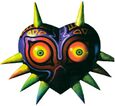m (I previewed how to bring the text up. This is pretty much the solution. Not to sound silly but I like problem solving.) |
m (template update, Replaced: {{Zelda}} → {{The Legend of Zelda}},) |
||
| Line 31: | Line 31: | ||
{{Continue Nav|nextpage=Controls}} | {{Continue Nav|nextpage=Controls}} | ||
{{ToC}} | {{ToC}} | ||
{{Zelda}} | {{The Legend of Zelda}} | ||
{{DEFAULTSORT:Legend of Zelda: Majora's Mask, The}} | {{DEFAULTSORT:Legend of Zelda: Majora's Mask, The}} | ||
Revision as of 18:06, 9 September 2009
The Legend of Zelda: Majora's Mask is the sequel to Nintendo's 1998 smash hit The Legend of Zelda: Ocarina of Time. Majora's Mask introduced the world to the unique artistic bent of director Eiji Aonuma, who would later return to direct such games as The Legend of Zelda: The Wind Waker.
While Majora's Mask was based on the same engine of its predecessor, it added a very vivid Japanese art design, and a new "72-hour" game system, wherein Link has a set amount of time to complete each dungeon or task. The implementation of the new time limit system was flawless and added much to the depth of the game.
Majora's Mask added a varied assortment of magical masks to Link's arsenal, which upon being worn, would bestow special powers upon Link. The many masks, in addition to the time system, make Majora's Mask one of the most unique games in the Zelda series.
Unlike the GameCube and Wii VC version, you need the expansion pack in order to play the original N64 version.
Aside from its original Nintendo 64 publication, Majora's Mask has only been released on the Nintendo GameCube's The Legend of Zelda: Collector's Edition.
More recently in April 7 2009, Majora's Mask is now available on the Wii through Virtual Console.

